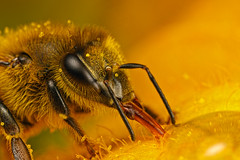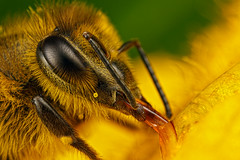When I press the shutter release on my camera the flash sends out a short burst of light that the camera’s metering system uses to determine how long the main flash pulse is going to fire. If the subject fills the frame, or there is something close behind the subject for the light to bounce off of, then odds are the light meter in the camera will be able to correctly determine how long to turn on the flash to give me a properly exposed image. But if the subject doesn’t fill the frame, and there isn’t anything close in the background for the flash to bounce off of, then the light meter is going to turn on the flash so long that I’ll probably get an over exposed image. That’s how Evaluative–Through The Lens (E-TTL) flash metering works. To get the most consistent results with E-TTL I need to get as much of the metering flash burst back into the lens as possible, and that’s what I’ve done with this field studio:

The trick is to initially bate the flowers that the bees are feeding on. Once the girls get into the habit of looking for the corn syrup (believe it or not it will take them a while) simply cut a piece of the flower petal, place it in a convenient spot close to where the bees are feeding, and set up a back drop (in this case a leaf). You’ll get better E-TTL metering since there’s a backdrop to reflect the metering pulse back into the lens, and you’ll have more time to concentrate on framing and composition because the camera is taking care of the exposure.

You can do a similar trick with dormant subjects –just cut the perch that they are using and hold it up in front of a leaf (or anything that will reflect light back into the camera and give you a pleasing background):

Footnote: The light meter in most cameras samples the frame at the same areas as the auto focus system. So a camera with more auto focus points will typically have a more accurate light meter.
Until next time, happy shooting :)
John


8 comments:
Good explanation, John. Now I understand even better why, more often than not, my subjects tend to get 'over flashed' when there's no nearby background. How ya been? Still hot as Hector here in TX but it's getting better.
Kenny
Thanks Kenny -was hoping that I explained that well :)
The weather here is starting to turn, feels more like fall every day.
Thanks for that explanation on how the flash metering works with E-TTL.
It finally explains to me why it messes up when further away from subjects too. Same problem the background is not there.
Very true Chris -the light meter in the camera is exposing for the subject, so the background ends up dark.
Thanks for the explanation... I need to carry around a few big leaves with me wherever I go now ;) I wondered if you're using high-fructose corn syrup as bee bait? I'm guessing not, but I just wanted to check, as I was a little concerned given studies that show a potentially harmful substance may form in high-fructose corn syrup that may contribute to honey bee deaths and colony collapse disorder (I use local, raw, unprocessed honey myself when baiting bees). For more info on HFCS and HMF see http://www.sciencedaily.com/releases/2009/08/090826110118.htm (this article links to the original scientific article, but the latter requires payment to view).
@ Elise: Actually I do use corn syrup as bait because some beekeepers say not to use honey -seems like I can't win!
I'll go back to using honey as well, since the quantities that I use shouldn't be harmful. Thanks for the article link!
This may be a silly comment, but I just wanted to say that the photo of the little bee hanging onto the twig (gymnast) is adorable in ways that boggle my mind.
I just got myself a flashgun for my 30D so this post was quite useful for me!! I used to used flash years ago before we had TTL flash and everything was done manually, with tape measure and patience-these days it is so much eaier!
Post a Comment